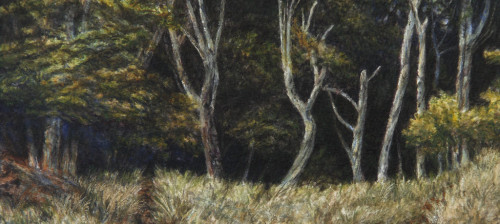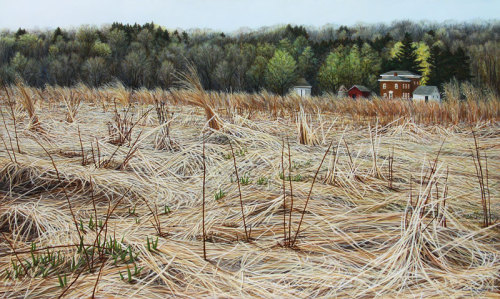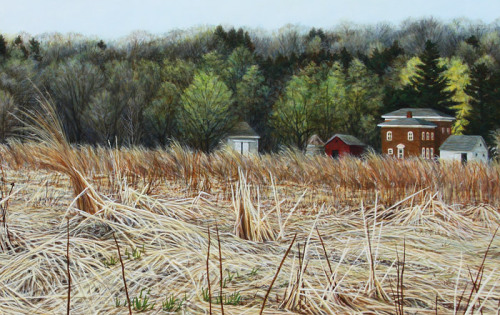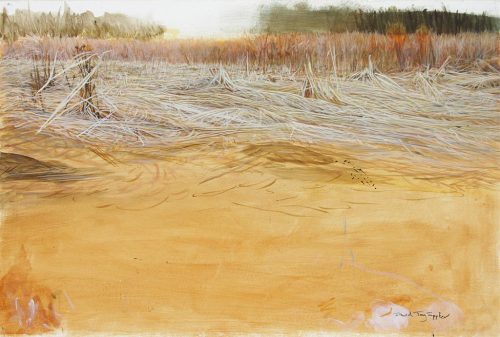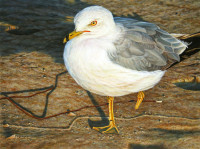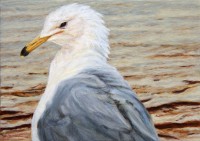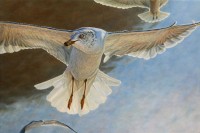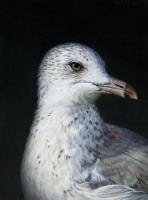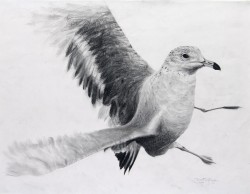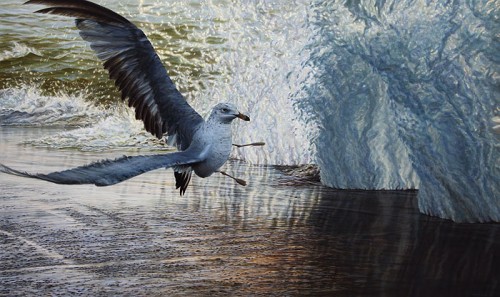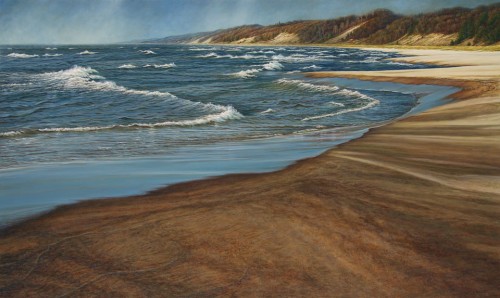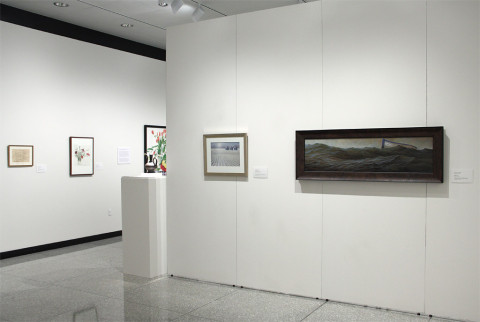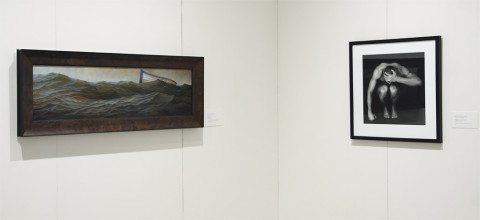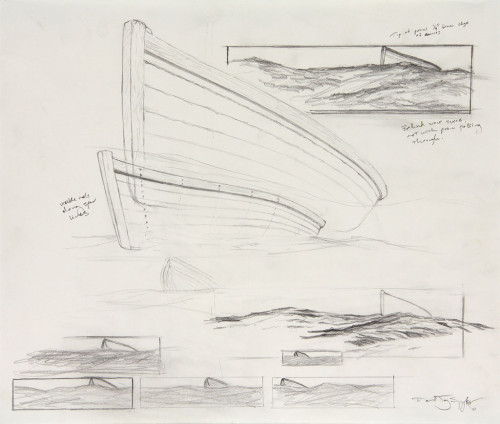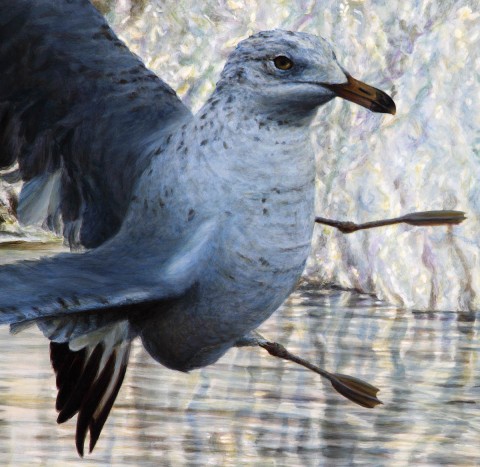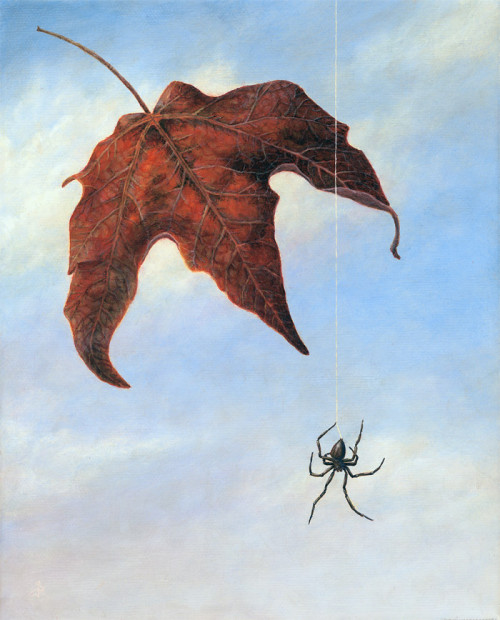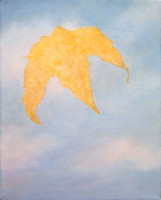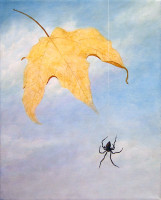Artistic Motivations: Drybrush Dunes Trees Watercolors
by David Jay Spyker
leave a comment
Barricade
In this watercolor and drybrush piece we’re on the beach of Lake Michigan looking back toward the woods that rise up out of the dunes. The woods’ edge is akin to a dark, mysterious barrier, very primal and wild to me. Ever since childhood, the sight of a wooded tree line has always excited a sense of curiosity and a desire to explore.
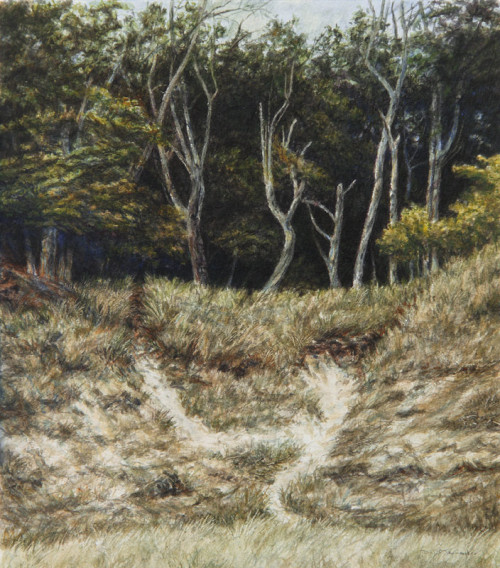
Barricade, 2010, Drybrush and Watercolor on Paper (Fabriano Artistico 300 lb. Cold Pressed), 12 1/2 x 11 in.
Trish and I were at Hoffmaster State Park, just north of Grand Haven, Michigan. At the end of the day, we were heading out of the park at closing time – pretty much right on the minute – with 6 or 7 other cars only to find the kid manning the gate had locked it already. We had to sit there for over an hour while we waited for someone to come from the nearby campground to let us all out.
I am always happy when a title comes to me that fits more than one meaning; “Barricade” seemed perfect for this little painting.
Artist's Statements Artistic Motivations Exhibitions: Artist's Statement Exhibition Kalamazoo Institute of Arts Painting Philip Jamison Spring Winter
by David Jay Spyker
leave a comment
“Double Take: Artists Respond to the Collection” at the KIA
When asked if I’d like to be part of Double Take at the Kalamazoo Institute of Arts, I was more than happy to participate. A show in which I get to pick a piece from the collection and create my own work in response, and then the two would hang side-by-side? Of course I wanted to do it!
Subsequently browsing the collection on the Institute’s website, then visiting the vault to see my possible selections in person was a treat. There is some really great art in the KIA’s collection. In the end, I chose a watercolor by Philip Jamison titled “Milkweed” as my companion piece.
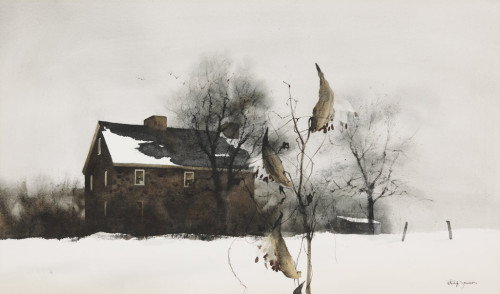
Philip Jamison, American, b. 1925
Milkweed, ca. 1950-1960
Watercolor on Paper
Collection of the Kalamazoo Institute of Arts; Gift of Mr. and Mrs. Donald S. Gilmore
Copyright Philip Jamison, image used by permission of the artist
The quiet atmosphere and solitude in Milkweed immediately made me think of a special place just a few miles from home, though I planned to paint my scene in a different season that was more personal to me.
As part of the exhibition, we were asked to write a short text speaking to the relationship of our work to our chosen piece, which would display with the paired art.
To me, Milkweed has a certain sense of quiet isolation, a solitude, which I am often looking for in my own work. When I manage to catch that mood in a scene, I feel like I’ve done something special with the painting. I can only imagine Philip Jamison must have the same sense of satisfaction when he captures a deep feeling in one of his own works.
There is a prairie tallgrass field north of Kalamazoo, and in early Spring, gentle breezes tickle last year’s dead stalks to create a quiet, pervasive whisper. If you stand for a while – with nothing but that dry rustling and the occasional bird song all around – and feel the changing vernal light and the zephyrs on your skin, you begin to get a sense of magic; it’s as if the whole world is whispering something unknown, yet deeply important.
I wrote to Mr. Jamison to tell him about the exhibition, and to ask if it would be alright to use the image of his painting for this article. What a thrill it was to read Philip’s letter in response! At 89 years of age he writes that he has been “unusually busy” lately. I hope to one day reach that age and still be busy making art.
He also writes “I have used milkweeds in many of my paintings simply because they are so prevalent in my part of Chester County…. I have vases of them in my studio…. and they have been there for over forty years”. That got me thinking of when I was a kid wandering the woods and empty fields near my house in Rochester, New York, and how each year the milkweed pods were such a source of fascination.
It was irresistible to pluck them and pry them open; I’d get the sticky milk all over my fingers, and explore how the seeds were packed inside with their silky threaded parachutes. Later in the year, when the pods would eventually split open on their own, I just had to blow handfuls of those seeds into the air.
Even today, on walks through fields, it makes me happy to see milkweed plants, and sometimes I still stop to play with the pods.
“Double Take: Artists Respond to the Collection at the KIA” is at the Kalamazoo Institute of Arts from 8/16/2014 – 1/18/2015. The show features the works of thirty area artists displayed with their corresponding selections from the KIA’s permanent collection.
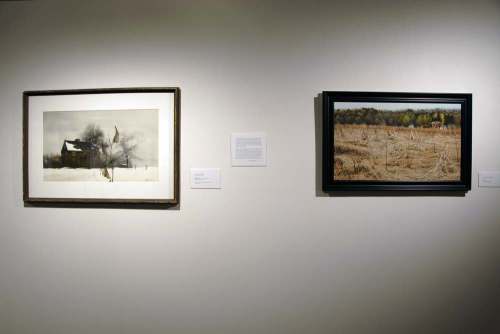
Philip Jamison’s “Milkweed” with David Jay Spyker’s “Whisper”
hanging at the Kalamazoo Institute of Arts
Photo courtesy of the KIA
Kalamazoo Institute of Arts, 314 S. Park St., Kalamazoo, MI 49007
www.kiarts.org
Artistic Motivations: Acrylics Drawings Painting Seagulls Water
by David Jay Spyker
leave a comment
Gulls
Much like I’ve used boats and houses as metaphor for humanity, I’ve come to include seagulls as well. If you watch a large flock, you start to see how their society is arranged with its own hierarchies. You’ll notice the greedy squabbles, the games they play on a breezy summer day, and the clear – sometimes vicious – pecking order there is within the flock.
Amputee is a portrait of one particular gull I saw regularly at the north beach in South Haven. It had lost a foot to fishing line but in spite of the difficulty of landings and take-offs, it kept on going.
When I’d feed the flock there, this one was always at the front, and the others would give it a wide berth. It had a bit of a cantankerous spirit. People don’t always notice the missing foot right away, but when they read the title it clicks. There is a real expression of the tenacity of life here, and I’ve tried to capture that in the way the gull stares back with directness and defiance.
I’m a night owl, and to me the gull in this small piece (only 5 x 7 inches) looks like how I feel if I get up early in the morning, so I titled it “Self-Portrait in the Morning as a Gull”.
It’s amazing how quickly a hundred or more gulls will show up if you start tossing out bread or french fries. In “Compass” I wanted to record that experience. When you feed them, you’ll end up with two groups: one with the more timid gulls on the ground, the shyest standing farther away, and the second group flying in to catch thrown food mid-air.
The fliers have this regular routine where they form a sort of queue and work their way to within about a foot, then they hover there as long as possible. Occasionally the second gull in line will give the first an impatient peck in the back. They’ll look you right in the eye; it’s an intense, piercing sort of stare.
You can toss them food and the lead gull will catch it. If you hold up a fry, one will snatch it right from your fingers – their instinct to keep a safe distance gets put aside for their greed for food. Then it will veer off to eat mid-air while it circles around to the back of the line. They’ll just keep this up, cycling around and around, until you run out of food.
The title refers to the regular circling pattern, as well as the keen sense of direction that birds possess. I suppose it also speaks to the circular patterns of life.
To the right is another small one – 8 x 6 inches. I wanted to capture a particular quiet stare, and when it was finished I felt an odd personal connection, so it ended up getting the title “Baroque Self-Portrait as a Seagull”. The dark background and the lighting help reinforce the sense of a traditional baroque portrait.
In “Startled Gull”, I wanted to capture a sense of movement along the wings while retaining a stillness around the head and body, so I used quick finger smudges along the back edge of the lower wing.
“Sudden Flight” depicts the same seagull startled by waves of water jetting up along a soaked pier in South Haven, Michigan. There is something fleeting and fragile about life with the chaotic frenzy of the water crashing up behind the gull. It seemed so small and at the mercy of the greater power of nature – so transitory.
Click here to read a previous article about “Sudden Flight”.
Artistic Motivations Exhibitions: Artist's Statement Exhibition
by David Jay Spyker
leave a comment
At the Water’s Edge
You are invited to the opening of “At the Water’s Edge” this Friday, August 15, 2014 (5:30- 7:30 pm) at the Box Factory for the Arts in St. Joseph, Michigan. This solo exhibition features 25 recent works, and runs 8/15 – 9/27.
The mood of a painting has always been very important to me. I
know I’m on the right track with a painting when I can start to feel
the subject – smell the water, taste the air, feel the temperature, hear
the wind or the waves.I have an obsession with the changing seasons and the passage of
time. The way the light changes over the year is endlessly
fascinating. Weather is the same – it’s so amazing, something full of
wonder.The season should be something you just instinctively know when
you look at the painting. If you can feel it too, then I’m on the right
track; if you’re also hearing the water or smelling the air, then I’m
really on the right track.If I’m to have an interest in it, I need to really feel my subject, and if
I don’t have an interest in it, I won’t be able to find its essence and
bring it out in the end. It’s a sort of creative circle that needs to be
complete. Ultimately, I’m after the emotional character of the
subject.
“At the Water’s Edge”, Solo Show, Box Factory for the Arts, 1101 Broad Street, St. Joseph, MI 49085
Artistic Motivations Exhibitions: Boats Exhibition Kalamazoo Institute of Arts Preliminary Study Water
by David Jay Spyker
leave a comment
“Cradle” Displayed in “Copley to Kentridge: What’s New in the Collection?”
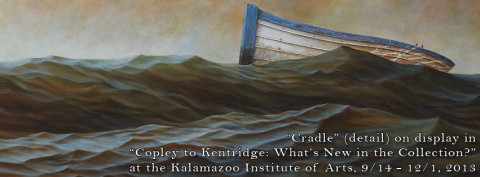 The painting, Cradle, joins more than 100 other recently acquired works in “Copley to Kentridge: What’s New in the Collection?” at the Kalamazoo Institute of Arts.
The painting, Cradle, joins more than 100 other recently acquired works in “Copley to Kentridge: What’s New in the Collection?” at the Kalamazoo Institute of Arts.
Completed in 2011, Cradle entered the permanent collection of the KIA in 2012. It will hang with works by notable artists such as George Tooker, John Singleton Copley, Robert Mapplethorpe, Jackson Pollock, Stephen Hansen and many others.
In 2012, Cradle won 1st place at the Regional Fine Arts Competition at the Carnegie Center for the Arts in Three Rivers, Michigan. It also took the 2nd place award at the Michiana Annual Artist Competition (10th MAAC) at the Box Factory for the Arts in St. Joseph, Michigan the same year.
Whether it’s a river, one of the Great Lakes, the ocean… water, to me, is an expression of spirituality, healing, and the timeless power of nature. It might represent a journey, or reference change over the course of time. It’s the source of life for all living things, and at the same time can engender something primeval and elicit emotions of unease or even danger.
The title of a piece has always been very important to me. When I choose a title, it comes from my own personal understanding of the painting. The meaning may not be immediately apparent on an outward level, but the title should reference my own thoughts and feelings about the image. Very often, the title will point to several different meanings, and when it does I feel I’m really getting something right.
In Cradle, I’ve used the boat as a metaphor for both the individual and humanity as a whole. The old boat also has the shape of a cradle of sorts. It carries us on the water, which here represents all of life. The water becomes a cradle for the boat, and encompasses birth, life, and death.
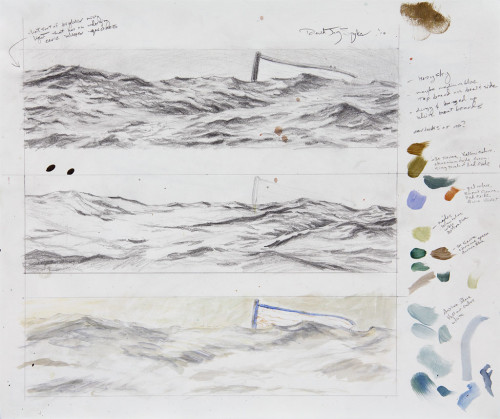
Study for “Cradle”, 2010, graphite, watercolor, and acrylic on paper, 14 x 16.5 in., by David Jay Spyker
When Cradle was at the 2012 competition in St. Joseph, Michigan, a woman who was part of a creative writing group there came up to me and said they each had to choose a piece in the show and write a story based on it. She chose Cradle, and said she imagined there was a man lying in the boat, that he had been there a long time, and whether he was alive or dead was something of a mystery. I felt Cradle conveyed a sense of strange mystery as well, so hearing what she said was encouraging.
Thoughts and especially emotions are something I’m trying to conjure when someone looks at my art, so people’s interpretations of my paintings – learning what kind of thoughts and feelings they have when they engage with it – that’s always interesting.
“Copley to Kentridge: What’s New in the Collection?” is on display 9/14 – 12/1, 2013 at the Kalamazoo Institute of Arts, 314 S. Park St., Kalamazoo, MI 49007.
Distant Light
At barely four inches tall, it’s not a grand landscape on the scale of a Church or a Bierstadt, but it feels so much larger to me. Distant Light looks north along the Lake Michigan shore from a spot above the mouth of the Kalamazoo River. At the farthest point of land lies the lighthouse that guards the entrance to Macatawa Bay in Holland, Michigan. That reference in the title is clear enough; it’s the rest of the story that’s not so obvious.
The season is pushing hard through autumn after all the summer people have abandoned the lakeshore. The days are growing shorter, the weather’s character has changed to match, and the sun is nearing the flat, dark line of the lake’s horizon. The light will soon be lost to another day.
I cherish this time of year.
My wife and I have walked these shores countless times in all seasons – so much time spent and memory earned. Trips to Saugatuck, South Haven, Holland, Grand Haven; the lake is never far from your mind here. My parents used to own a home on the lake not far from that lighthouse. Visits always meant a walk on the beach.
Tricia and I were married on a mist-shrouded June day up that coast, just a twenty-minute walk south of Big Red. It was an amazing gift of a day. It had rained nine inches over night and into that morning, and from the bluff we could only see a six foot strip of water through the rolling fog – sometimes even the shore was hidden. There could not have been a more magical day to marry my best friend at the lake in June; the quiet and peace… I still get chills when I think about it.
This little painting is a distillation of two decades worth of memories and emotions. The distance here is both physical and temporal. The light sits at the tip of the farthest point, it sets over the water and slants in to illuminate a patch of dune, and it shines on in our hearts and minds.
Art Artistic Motivations: Acrylics ArtPrize Birds Drawings Drybrush Painting Water Watercolors
by David Jay Spyker
leave a comment
Sudden Flight
I was in South Haven, Michigan, out on the north pier watching jets of water shoot up in the recesses along the steel side as the waves rolled in. This gull had been standing there on the soaked concrete, looking at me instead of the water behind, when it was startled into flight.
I felt this was a great image, and revisited it on and off for months. It started out as a thought about how life is fragile, and tied in with how I’ve been seeing gulls as metaphors for people. Here was this bird with all the world crashing around, and it seemed so small and at the mercy of the greater power of nature – so transitory.
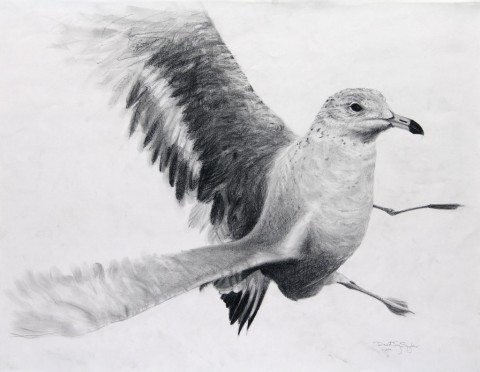
“Startled Gull” (Study for Sudden Flight), 2011
Graphite on Paper, 23 x 29 in., by David Jay Spyker~click to enlarge~
It took some time for the deeper personal connection to percolate up, and motivate me to actually get started on the painting:
When the phone rang the second time, I had a feeling something was wrong. Mom’s in the hospital; she had a massive stroke and might not live more than a day. That’s not something you want to hear.
I was on a plane bound for Florida early the next morning, a sudden flight filled with fears and barely restrained, intense sadness.
In spite of the reality of the situation – knowing that this wasn’t going to end with a miracle – hope would come and go throughout each day as I sat in the hospital room, traveled with family to a second hospital that had neurology specialists, and watched mom hooked up to tubes, machines, and monitors.
When you’re sitting there, and hope is not with you at the moment, a vacant numbness takes its place. These two things trade off, back and forth, and mix in with other powerful emotions to make a thick stew.
She never woke up. Her sudden flight had already happened about a week before she finally passed away.
Losing a parent changes something deep inside of you, way down in your core. The truth of your own mortality is never more clear. If you’re fortunate, you come away with the beginning of a more profound understanding of your own heart, and of the things that give meaning to your life.
The thing about life is we never know how much time we have. There is a glass-like fragility to life, to being out there in it all and experiencing the world through this gift we’ve been given.
Get out there and do something meaningful. Live with purpose. Try to be a better human being, be kinder, be more understanding, and especially be more open. That’s how I want to live.
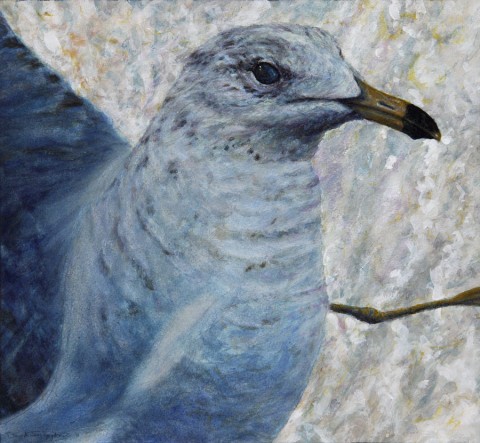
“Startled Gull” (Study for Sudden Flight), 2011
Watercolor and Acrylics on Paper (Lanaquarelle 140 lb. Cold Pressed)
10 5/8 x 11 1/2 in., by David Jay Spyker
~click to enlarge~
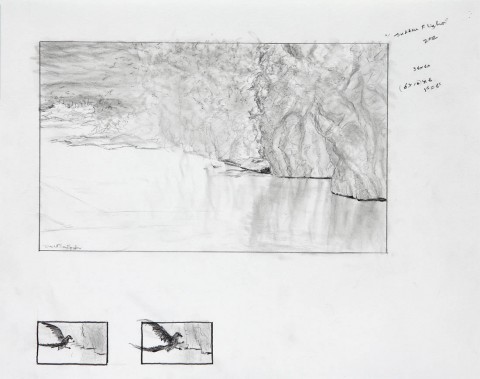
Study for Sudden Flight, 2012, Graphite on Paper (Stonehenge 100% Cotton)
11 x 14 in., by David Jay Spyker
~click to enlarge~
Sudden Flight is displayed in ArtPrize from September 18 – October 6, 2013 at St. Cecilia Music Center, 24 Ransom Ave. NE, Grand Rapids, MI 49503. If you’ll be visiting ArtPrize, please stop by St. Cecilia’s to see the painting.
ArtPrize 2013 Vote Code: 54406
Art Artist's Statements Artistic Motivations: Art Philosophy Artist's Statement
by David Jay Spyker
leave a comment
Artist’s Statements, Part 2
You might like to start with Part 1
I recently wrote about my initial reluctance toward having any artist’s statement for my show (Memory, Essence, Mystery). As I thought more and more about it, and began to write, the words also came more easily. I ended up with, in addition to the statement in the catalog, three other statements spaced around the exhibition room. They really helped to tie everything together, and make that personal written connection between the art and the people looking at it.
Each of the three wall cards dealt with an aspect from the show title, though they were not specifically labelled as such:
Memory
There is a relationship to personal experience in my art. What may seem like an “ordinary” landscape or shore scene actually has personal significance to me; it has memory tied to it. Sometimes, there is a reflection of that in the title of a painting. You may not know the exact connection at a glance, but it’s there.
When we interact with people, or engage with places, they become more important to us. We are woven into their fabric, and they into ours. It’s not the place that is significant, it’s what we did or felt while we were there. Each of us also has those special possessions, which mean a lot to us because of the memories surrounding them.
Personal memories and experiences are frequently expressed in my work. I’m trying to talk about them, and my thoughts and feelings that encompass them; I’m just using a visual language to do it.
Essence
There can be a lot of artistic editing that happens when I’m working out a painting based on life. I may alter colors and tones, modify some forms, or even leave out or add certain elements.
For me, there is more leeway when dealing with a landscape than, say, a portrait of a person or a bird – there you want to get the depiction of form and the inner character right.
Getting every branch on a distant tree to match what I see in the landscape isn’t so important, but finding the character of the landscape is. I may change the lighting in a scene so it works toward the emotion of the whole picture.
What matters most is that the picture express how I feel about the subject. I want the deeper character, or essence of it to come through; you should really feel something when you look at it.
Of course, some pieces are complete fabrications, and then any “rules” really fly out the window. It becomes about imagination and creating something that has the emotion I’m after, and says what I want to say.
Mystery
Like Andrew Wyeth’s quietly disturbing, highly personal images or the silent, still moment of a Vermeer, I want to capture a feeling of strange wonder that there may be something deeper and mysterious going on in a painting.
Even when it seems ordinary at first glance, I am so often trying to find something subtle – the lingering of something left unspoken or a kind of breathlessness – a stillness.
Whatever it is, if I can find that deeper emotion and work it into the picture, then I know I’ve done something right. I’m on the right track.
Art Artistic Motivations: Art Philosophy Artist's Statement
by David Jay Spyker
leave a comment
Artist’s Statements, Part 1
Let’s start by saying that as I have matured over the years, I have also become less of a fan of artist’s statements – you know, those paragraphs you see in a show catalog or hanging in the exhibition that explain who the artist is, why they do what they do, and what their work means.
Too often they read like pseudo-sophisticated bullshit that’s tailored to self-stroke the artist’s own ego, to display an intelligence and mastery of the complexities of language, or are designed to appeal to some sort of elite art world ideal.
As I considered what to say about my own most recent show (Memory, Essence, Mystery), I went through a range of emotions on the subject. I considered not even having a written statement in favor of letting the paintings and drawings simply speak for themselves, but eventually decided against it because it was still important to make that connection with the viewer about the work.
When I create art, it’s like writing in a visual language; not everyone thinks that way – a great many people think in words, and there is a communication gap there. Coming up with something to say about my work – to bridge that gap and forge a stronger connection – became important again.
It was also important to speak from the heart because that is the origin of my art; I didn’t want to intellectualize it, and risk losing that chance to speak about my work in a way that would click with people on an emotional level.
The best course for me was to write more like I might speak, to honestly transcribe the words I could hear in my mind without dressing them up in fancy clothing. This is what ended up being printed in the show catalog:
My paintings always have some kind of personal story or significance. There has to be that connection, whether it’s something coming from deep within, an inspiration tied to someone in my life, or memorable experiences that have shaped the way I feel and think about the world around me. Most often it’s all of those things. I feel very fortunate in that regard – to be able to weave those threads together in my art, and have that sort of personal connection on all those levels, because putting that down in a visible, tangible form is how I talk about life. In the end, it’s about personality, what’s in your heart, what you love – you know, that’s what makes your art great, that’s what gives it feeling. Without all of that coming through, what’s the point?
Work from the heart – write from the heart.
Falling
In Falling, the seasonal reference is pretty obvious in the title with the leaf falling and the spider dropping down. My wife and I talk about how spiders also really seem to come out in force as autumn sets in, so I painted this as a gift for her.
I found a couple of digital images of this piece in progress, so I’ve included them below to give a little insight into the process involved with this particular painting. In the first image you just barely spot a pencil line where the silk thread will be. The leaf is underpainted in yellow ochre and given multiple layers of varying transparency (many of them glazes with acrylic medium) over it to achieve a richer color depth.
In the second image you can see where I am beginning to define the veins, the stem, and the underside areas of the leaf with burnt sienna.
Between the second image and finishing the piece, I painted in some more semi-transparent whites over the violet-toned area at the bottom and left in order to push it back a bit since it was just coming on too strong.
All paints and mediums used were by Golden Artist Colors.
